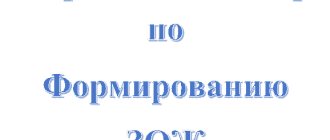Summary of educational activities on OO Communication" (section "Speech Development") with children of the middle group
Abstract of NOD on OO Communication" (section "Speech Development"). Compiling descriptive stories on the topic: “Vegetables” with children 4-5 years old
Compiling descriptive stories on the topic: “Vegetables” (according to the diagram).
Educational area: “Communication” (section “Speech Development”) Integration of educational areas: “Cognition”, “Socialization”, “Physical Education”. Types of children's activities : gaming, communicative, cognitive and research. Objectives: Educational:
learn to describe vegetables, name them correctly;
clarify the idea of vegetables; teach to identify a certain property in vegetables. Summarize and systematize children’s knowledge on this topic. Form generalizing concepts of “vegetables”, “harvest”. Expand and activate your vocabulary on this topic. Practice forming adjectives from nouns (carrot, tomato, beetroot, cabbage). Developmental:
develop attentiveness, fine motor skills of the fingers.
Develop tactile perception, articulation apparatus, memory, attention, thinking. Educational:
to instill in children a sense of unity, cohesion, increase self-confidence, and create a positive emotional background.
Planned results: knows how to maintain a conversation, express his point of view, expresses positive emotions, participates with interest in active speech games. Vocabulary work: active vocabulary - vegetables, harvest Individual work : practice forming adjectives from nouns. Demonstration material: a dish with vegetables: carrots, tomatoes, cucumbers, onions, beets, cabbage, potatoes, raw carrots and cabbage, boiled beets, potatoes, diagram for describing vegetables. Preliminary work: observation of work in the garden, examination of vegetables, description of objects according to Tkachenko’s scheme. Progress of GCD: I. Organizational moment. Children stand in a semicircle near the chairs. Educator: Today in class, guys, we will continue the conversation about vegetables, and you tell me everything you know about them. Let's play the game: "Name the vegetable." The one who named the vegetable sits down. Children, naming a vegetable, sit on chairs. II. Main part. The teacher shows a dish with vegetables. Educator: How can you call in one word what is on our plate? Children: Vegetables. Educator: What is this? (teacher shows a cucumber) Children: Cucumber. The teacher, together with the children, describes the vegetable according to the diagram. Educator: What color is it? Children: Green. Educator: What shape is it? Children: oblong. Educator: Is the cucumber big or small? Children: The cucumber is big. Educator: What does it taste like? Children: Juicy, crispy Educator: Where does a cucumber grow? Children: in the garden. Educator: What can you cook from it? Children: Salad. Educator: Now listen to me tell you about the cucumber. This is a cucumber. It is green, oblong, small, juicy, crispy. The cucumber grows in the garden. You can make a salad from cucumber. Children look at tomatoes, carrots, onions, cabbage and say something like this: “This is cabbage. It is white, round, big, juicy. Growing in a garden bed. You can prepare a salad, cook cabbage soup.” “This is an onion. It is golden in color, round, and slightly bitter. Growing in a garden bed. You can put it in the soup.” Educator: Well done! Now let's play the "Guess the Taste" game. The teacher calls 1 child to come to him. The child closes his eyes and the teacher gives a piece of carrot. The child eats, and the teacher clarifies what it is, the properties of carrots: hard, crunchy, sweet. Calls the 2nd child, asks him to guess the taste of boiled beets, the teacher clarifies what it is, the properties of beets: beets are soft, sweet. Educator: And now you and I will salt the cabbage. We chop, chop the cabbage (Movements with straight palms on the table) We three, three carrots (Movement of fists towards and away from ourselves) We salt, salt the cabbage, (Imitation of sprinkling salt with fingers) We squeeze, squeeze the cabbage. (Intense clenching of both hands into a fist) Educator: Guys, what did we do with the cabbage and carrots? Children: We pickled cabbage and carrots. Game "Guess the vegetable by description." Educator: (hides the dish with vegetables behind the screen). Let's play the "Guess the Description" game. The one I call will go behind the screen, take out one vegetable and tell what it is, but will not name it. And you have to guess what it is. For example, if I tell you: green, oblong, juicy, tasty, then you will guess that it is... a cucumber. 2 children talk about vegetables. The teacher evaluates the children's answers. Educator: Where do vegetables grow? Children: In the garden. Physical exercise “Gathering the harvest” The children walked, walked, walked, children walked in place.
They entered the garden.
They found cabbage, bent down and picked vegetables
, found cucumbers, collected all the tomatoes, found zucchini, put everything in baskets and went home.
walk in place
Children sit on chairs.
Educator: What vegetables can you cook? (children's answers). Educator: That's right, guys, you can make juices from vegetables. The teacher displays a picture. Educator: Show and name which glass contains which juice. 1 child is shown and called juices. Educator: Now listen to pure sayings about vegetables and name the missing word (Children pronounce pure sayings). Ets-ets-ets - the green...... cucumber is ripe. Or-or-or - grew big....... tomato. Uk-uk-uk - very bitter…………. onion. Ow-ow-ow - I ate sweet... carrots III Summary of the lesson. Educator: Our lesson is over. - Tell me, what did we talk about today? -What did you like most about the lesson? — Which game did you like best? - Well done!
We recommend watching:
Summary of GCD in the middle group. Coal GCD notes on artistic creativity in the middle group “Fish in the Aquarium” GCD notes in the middle group on the topic Autumn GCD notes in the middle group on the topic: “Who draws pictures in books?”
Similar articles:
Summary of GCD in the middle group. Game-dramatization based on the Russian folk tale “Teremok”
Educational field "Communication" (secondary group)
| Levels | Didactic games, exercises, questions | Criteria for evaluation |
| I. Level of vocabulary development | 1 Game “Describe the object.” Material: various subject pictures. Contents of the diagnostic task: The teacher shows one picture at a time, for example: a ball, a hat, a bucket, flowers. Asks to answer the questions: - What is this? (Ball.) - What is he like? (Red, big, airy.) - What can you do with it? (Play, roll on the floor, throw, kick.) 2 Didactic game “Finish the sentence.” Contents of the diagnostic task: The teacher invites the child to play the game “Finish the sentence.” “I’ll start the sentence, and you think about how you can finish it.” - Sugar is sweet, and pepper... (bitter). - The road is wide, but the path... (narrow). - Plasticine is soft, and stone... (hard). - The stepmother is evil, and Cinderella... - Karabas-Barabas is evil, and Papa Carlo... etc. | 1 point - poor vocabulary, difficulty in choosing antonyms. 2 points - understands and uses antonym words. Makes mistakes or finds it difficult to determine the various properties and qualities of objects, aesthetic characteristics. 3 points - the child actively uses words denoting emotional states (angry, sad), ethical qualities (cunning, kind), and aesthetic characteristics. |
| I. Level of vocabulary development | 3. Task “Tell me about the boys.” Material: plot picture depicting two boys: one is clean, neat, cheerful, the second is sloppy, sad. Contents of the diagnostic task: The teacher asks the child to look at a picture of two boys. Then he organizes a conversation on the following questions: - What can you say about boys? Are they in the same mood? - One boy is cheerful, but what about the other? (Sad.) - Is it good to be sloppy? - What should you do to be clean and tidy? - Which boy do you like? Why? And so on. | |
| II. Level of formation of the grammatical aspect of speech | 1. Didactic exercise “Setting the table.” Material: tea set (For dolls), object pictures depicting food products (models). Contents of the diagnostic task: The teacher offers to look at the dishes and answer questions. - How can you name all the objects? (Draws attention to the tea set.) Name famous pieces of utensils. — What products are needed to treat a person to tea? (Sugar, tea, crackers...) - Which bowl should I put the sugar in? (Into the sugar bowl.) - And what about the crackers? (Into the rusk bowl.) Etc. - Arrange the dishes beautifully. -Where is the teaspoon? (Next to the saucer or to the right of the saucer.) Etc. 2. Exercise “Complete the sentence.” Contents of the diagnostic task: The teacher asks the child to come up with the ending of the sentence: “Night came and...” “Mom and I went to the store and bought...”. “I like winter because...” “We are doing exercises because...” Etc. 3. Didactic game “Hide and Seek.” Material: sets of toy animals (bear cubs, kittens, hedgehogs, foxes) or object pictures with their image. Contents of the diagnostic task: The teacher arranges toys (lays out pictures) and asks the child to name groups of animals. - These are fox cubs. - These are hedgehogs. Etc. Then the teacher asks to remember all groups of animals and invites the child to close his eyes. The teacher removes one group of toys. After the child opens his eyes, the teacher asks to name who is missing (bear cubs, kittens, etc.). | 1 point - the child cannot cope with the tasks. 2 points - it is difficult to independently form new words (sugar - sugar bowl), comprehends cause-and-effect relationships, mainly uses simple or complex sentences in speech, excluding complex sentences. Makes mistakes in forming the plural of nouns denoting animals. 3 points - the child forms new words by analogy with already familiar ones. Understands and uses prepositions in speech. Comprehends cause-and-effect relationships and composes complex, complex sentences. Correctly forms the plural form of nouns denoting baby animals. |
| III. Level of development of coherent speech | 1. Didactic game “The postman came to us.” Material: plot pictures “Seasons”. Contents of the diagnostic task: 4 children can participate in the game. The teacher selects postcards with a simple plot, but in such a way that it is clear what time of year the action takes place. The teacher reports that the postman brought postcards to all the children. Once children receive a postcard, they should not show it to each other. It is necessary to tell the plot in such a way that it is clear what time of year the action takes place. 2. Didactic game “Tell me about the toy.” Material: a set of different toys: a car, a ball, a doll, a bunny, etc. Contents of the diagnostic task: The teacher shows the toys and offers a sample story about one of them. Repeats it again, paying attention to the plan of the descriptive story. Then he offers to describe any of the toys according to the same plan. 3. Dramatization of the fairy tale “The Cockerel and the Bean Seed.” Contents of the diagnostic task: The teacher takes out a chicken, a cockerel, and a bean seed from a fairy chest. - What fairy tale do these heroes come from? - What happened to the cockerel? - Why do you think the cockerel choked? — Who did the chicken run to first for help? — What was the butter needed for? (A brief conversation is held about the fairy tale in order to remember its content.) Then the teacher invites the child to act out the fairy tale using the present. theater | 1 point - the child cannot, even with the help of an adult, talk about the content of the plot picture. Not able to describe a toy based on a model. When dramatizing a fairy tale, he mainly uses situational speech and gestures. 2 points - the child composes a story using leading questions. There are isolated cases of violation of the sequence in the description of signs. With the help of an adult, he dramatizes a familiar fairy tale. 3 points - the child talks in detail about the content of the plot picture, consistently writes a story about the toy. Knows how to dramatize passages from a familiar fairy tale. |
| IV. Sound culture of speech. | Didactic exercise “Identify the first sound in a word.” Contents of the diagnostic task: The teacher suggests playing with words. Asks the child to listen carefully as he identifies the first sound with his voice. OOO-la, AAA-stra, UUU-tka, etc. When repeating words, he asks to name the first sound. | 1 point – pronounces a large number of sounds with distortion, making it difficult to identify the first sound. 2 points - does not pronounce all sounds clearly, emphasizes the first sound. 3 points - meaningfully works on his own pronunciation, emphasizing the first sound in a word. High level 10-12 points Average level - 6-9 points Low level - 4-5 points. |
"From birth to school."
Basic general education program for preschool education / Ed. NOT. Veraksy, T.S. Komarova, M.A. Vasilyeva




